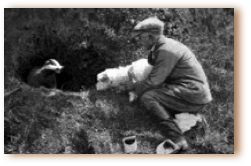
Sealyham Century Site

The Sealyham
As
A Working Terrier

By
William Baker
Master of the Kent and Sussex
Badger Club
(Photo of the author right)

Please take the time to read this article about the working Sealyham. It was published in the "Country World and Kennel News" magazine december13, 1918 .
There were great worries among the "working people" that the breeds ability to work would get lost. Today we all know how it ended.







